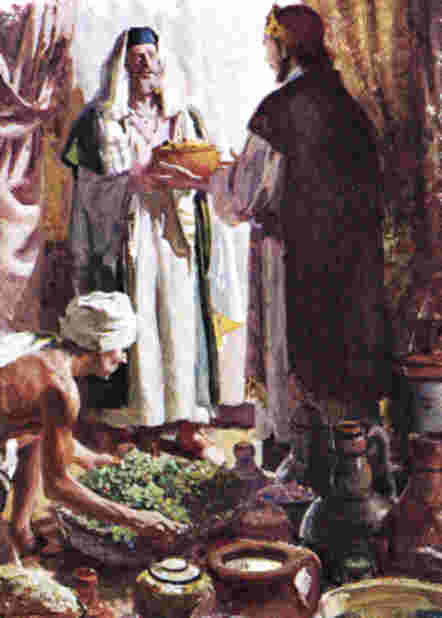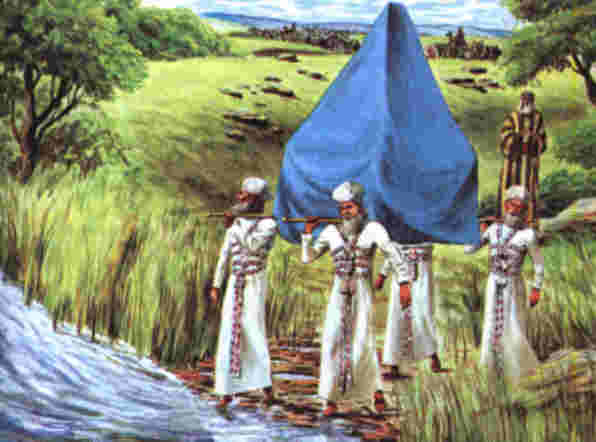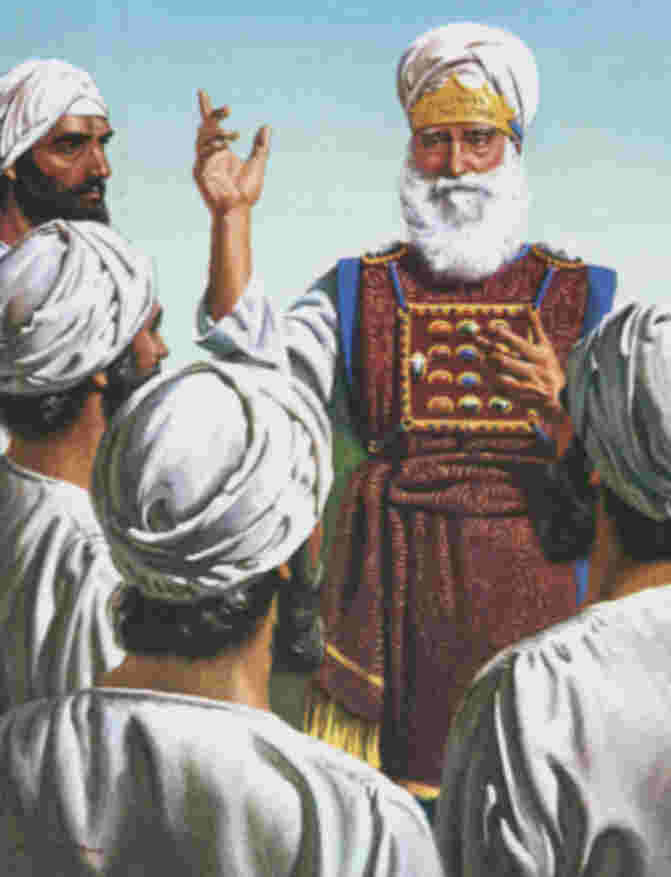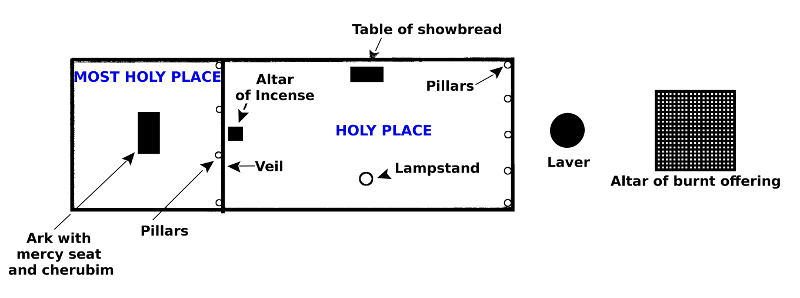Lesson 5October 26–November 1
Atonement: Purification Offering

Read for This Week’s Study: 2 Chron. 33:12-13; 2 Sam. 14:1–11; Lev. 4:27–31; Jer. 17:1; Lev. 10:16–18; Mic. 7:18–20.
Memory Text: “Knowing that you were not redeemed with perishable things like silver or gold from your futile way of life inherited from your forefathers, but with precious blood, as of a lamb unblemished and spotless, the blood of Christ” (1 Peter 1:18, 19, NASB).
The sacrificial system is, probably, the best known part of the sanctuary service because it’s the part that points directly to Christ’s sacrifice. The blood of the animal that died for the sinner becomes a symbol for the blood of Christ, who died for us.
This week we will study several concepts linked to the “purification offering” (also called “sin offering”), which was God’s appointed way of helping us to understand better how He is reconciling us to Himself through the only true sacrifice, Jesus Christ. At times this lesson, uses the term purification offering instead of sin offering to avoid the impression that, for instance, giving birth is regarded as moral fault because the new mother had to present such an offering (Lev. 12:5–8). This sacrifice is best understood as a purification offering for her ritual impurity, and not as a sacrifice because of sin.
Study this week’s lesson to prepare for Sabbath, November 2.
Sin and Mercy
As anyone who knows the Lord can testify, sin separates us from God. The good news is that the Lord has put in place a system to heal the breach caused by sin and to bring us back to Him. At the center of this system is, of course, the sacrifice.
There are basically three kinds of sin depicted in the Old Testament, each corresponding to the sinner’s level of awareness while he or she committed the transgression: inadvertent or unintentional sin, deliberate or intentional sin, and rebellious sin. The “purification offering” prescribed in Leviticus 4:1–5:13 applied to cases of unintentional sin, as well as some cases of deliberate sin (Lev. 5:1). While an offering was available for these first two categories, none is mentioned for rebellious sin, the most heinous kind. Rebellious sin was done “in the face” of God, with a high hand, and the rebel deserved nothing less than to be cut off (Num. 15:29–31); however, it seems that even in these cases, such as with Manasseh, God offered forgiveness (see 2 Chron. 33:12-13).
Read Deuteronomy 25:1-2 and 2 Samuel 14:1–11. What does 2 Samuel 14:9 reveal about mercy, justice, and guilt?
Is God justified in forgiving the sinner? After all, is not the sinner unrighteous and, therefore, worthy to be condemned (see Deut. 25:1)?
The story of the woman of Tekoa can illustrate the answer. Pretending to be a widow as instructed by Joab, she went to King David, seeking his judgment. Joab contrived a story about her two sons, one having killed the other, that he asked her to tell David. Israelite law demanded the death of the murderer (Num. 35:31), even though he was the only male left in the family. The woman pleaded with David (who functioned as judge) to let the guilty son go free.
Then, interestingly enough, she declared: “ ‘let the iniquity be on me and on my father’s house, and the king and his throne be guiltless’ ” (2 Sam. 14:9, NKJV). Both the woman and David understood that if the king would decide to let the murderer go free, then the king himself would acquire the guilt of the murderer and that his throne of justice (that is, his reputation as judge) would be in jeopardy. The judge was morally responsible for what he decided. That is why the woman offered to take over this guilt herself.
Similarly, God takes over the guilt of sinners in order to declare them righteous. For us to be forgiven, God Himself must bear our punishment. This is the legal reason why Christ had to die if we were to be saved.
Laying on of Hands
Read Leviticus 4:27–31. What ritual activities were performed along with the sacrifice?
The goal of the offering was to remove sin and guilt from the sinner, to transfer responsibility to the sanctuary, and to let the sinner leave forgiven and cleansed. (In extremely rare cases one could bring a certain amount of fine flour as a purification offering, and although this purification offering was bloodless, it was understood that “without shedding of blood there is no forgiveness” [Heb. 9:22, NASB]).
The ritual itself included the laying on of hands, the death of the animal, blood manipulation, the burning of fat, and the eating of the animal’s flesh. The sinner who brought the offering was granted forgiveness, but only after the blood ritual.
A crucial part of this process involved the laying on of hands (Lev. 1:4, 4:4, 16:21). This was done so that the offering “may be accepted for him to make atonement on his behalf” (Lev. 1:4, NASB). The offering applied only for the one who put his hands on the animal’s head. According to Leviticus 16:21, the laying on of hands would be accompanied by a confession of sin; this would acknowledge the transfer of sin from the sinner to the innocent animal.
The slaughter was, of course, basic to any animal offering. After the animal was killed, the spilled blood was used to make atonement on the altar (Lev. 17:11). Because the sins had been transferred to the animal by the laying on of hands, we should understand the death of the animal as a substitutionary death. The animal died in the place of the sinner. This may explain why the act of killing the animal had to be performed by the sinner, by the guilty one, and not by the priest.
Next time you are tempted to sin, envision Jesus dying on the cross and see yourself putting your hands on His head and confessing your sins over Him. How might this concept, played out in your mind, help you to understand just what it cost in order to be forgiven? How could this idea help you to resist succumbing to that temptation?
Transfer of Sin
“The sin of Judah is written with a pen of iron, and with the point of a diamond: it is graven upon the table of their heart, and upon the horns of your altars.” (Jer. 17:1).
After the laying on of hands and the death of the animal, the next ritual activity in the offering was the handling of the blood. The priest applied the sacrificial blood to the horns of the altar. Because blood was involved, this ritual part had to do with atonement(Lev. 17:11). If the sinner was a commoner or a leader, the blood was applied on the altar of burnt offering (Lev. 4:25, 30); if the high priest or the entire congregation was the sinner, the blood was applied to the inner altar, the altar of incense (Lev. 4:7, 18).
What did it mean to smear blood on the horns of the altar? The horns were the highest points of the altar and, as such, could signify the vertical dimension of salvation. The blood was brought into the presence of God.
Jeremiah 17:1 is of particular importance for understanding what happens: the sin of Judah is engraved “upon the tablet of their heart, and on the horns of their altars” (NASB). Although the text is referring to altars involved in idolatrous worship, the principle remains the same: the altar reflected the moral condition of the people. Blood transferred the guilt of sin. The blood smeared on the horns of the altar transferred sin away from the sinner to the sanctuary, a crucially important truth in order for us to understand the plan of salvation as revealed in the earthly sanctuary service, which symbolizes the work of Christ in heaven for us.
Because the blood carried sin, it also defiled the sanctuary. We find an example of this defiling in cases where the blood of the purification offering splashed accidentally on a garment. The garment needed to be cleansed, not just anywhere, but only “in a holy place” (Lev. 6:27, NKJV).
Finally, the burning of the fat on the altar indicated that everything about the purification offering belonged to God (Lev. 3:16).
Thanks to the death of Jesus, symbolized by those sacrifices, our sin has been taken away from us, placed on Him, and transferred to the heavenly sanctuary. This is central to the plan of salvation.
How does the sanctuary service help us to understand our utter dependence on God for forgiveness of our sins? What comfort does this truth bring you? At the same time, what important responsibilities follow? (See 1 Peter 1:22.)
Bearing Sin
By eating the offering at a holy place, the officiating priest would “bear away the guilt” of the offender. The meat of this offering was not just payment for the priests’ services (otherwise Moses would not have been so angry with Aaron’s sons for not eating of it), but it was a crucial part of the atonement.
How does the eating of the sacrifice contribute to the process of atonement? Eating was required only of those offerings in which blood did not enter the holy place; that is, the offerings of the leader and the commoner. The Bible explicitly said that by eating the sacrifice the priests would “bear away the guilt,” which would “make atonement” for the sinner. To carry the sinner’s guilt implies that the sinner now goes free.
In the Hebrew, Exodus 34:7 says that God “carries iniquity,” the same two Hebrew words used in Leviticus 10:16, where it’s clear that the act of the priest’s carrying the sin is what brings forgiveness to the sinner. Otherwise, without that transfer, the sinner would have to bear his own sin (Lev. 5:1), and that, of course, would lead to death (Rom. 6:23).
The priest’s work of bearing another’s sin is exactly what Christ did for us. He died in our place. We conclude, then, that the priestly work at the earthly sanctuary typifies Christ’s work for us, because He has taken upon Himself the guilt of our sins.
“The blessing comes because of pardon; pardon comes through faith that the sin, confessed and repented of, is borne by the great Sin-bearer. Thus from Christ cometh all our blessings. His death is an atoning sacrifice for our sins. He is the great medium through whom we receive the mercy and favor of God. He, then, is indeed the Originator, the Author, as well as the Finisher, of our faith.”—Ellen G. White, Manuscript Releases, vol. 9, p. 302.
Imagine standing before God in judgment. What would you lean on—your good works, your Sabbath keeping, all the nice things you had done and all the bad things you hadn’t done? Do you really think this would be enough to justify you before a holy and perfect God? If not, what’s your only hope in that judgment?
Forgiveness
Read Micah 7:18–20. What picture of God do we find in this passage?
The last three verses of the book of Micah focus on the relationship of God with His remnant. The text describes beautifully why God is unrivaled. He is incomparable because of His forgiving love and grace. The outstanding characteristic of God, as revealed in Micah (and elsewhere), is His willingness to forgive. Micah emphasizes this point by using various expressions for God’s attributes (vs. 18) and achievements (vss. 19, 20). His attributes and achievements are explained in the language of the Israelite Credo in Exodus 34:6-7, one of the most beloved biblical descriptions of the character of God.
Interestingly, several crucial words in Micah 7:18–20 are also used in the Servant Song in Isaiah 53, pointing to the fact that the means of forgiveness comes from the One who is suffering for the people.
Unfortunately, not everyone will enjoy God’s saving grace. God’s forgiveness is neither cheap nor automatic. It involves loyalty. Those who have experienced His grace respond in kind, such as we see in Micah 6:8, a central text in the book. Just as God “delights in unchanging love,” NASB, He calls His remnant to “love kindness” NASB. His people will imitate God’s character. Their lives will reflect His love, compassion, and kindness.
In the Bible, Micah 7:18–20, with its emphasis on forgiveness, is immediately followed by Nahum 1:2-3, with its emphasis on judgment. This unfolds the two dimensions of God’s dealings with us: forgiving the repentant and punishing the wicked. Both sides belong to God. He is Savior and Judge. These two aspects of God’s character are complementary, not contrary. A compassionate God can also be a just God. Knowing this, we can rest assured in His love, in His forgiveness, and in His ultimate justice.
Read Micah 6:8. What good is a profession of faith without these principles to reveal the reality of that profession? What’s easier, to claim faith in Jesus or to live out that faith, as expressed in Micah 6:8? How can you better do the latter?
Further Study: Ellen G. White, “The Tabernacle and Its Services,” pp. 343–358, in Patriarchs and Prophets.
“As Christ at His ascension appeared in the presence of God to plead His blood in behalf of penitent believers, so the priest in the daily ministration sprinkled the blood of the sacrifice in the holy place in the sinner’s behalf.
“The blood of Christ, while it was to release the repentant sinner from the condemnation of the law, was not to cancel the sin; it would stand on record in the sanctuary until the final atonement; so in the type the blood of the purification offering removed the sin from the penitent, but it rested in the sanctuary until the Day of Atonement.”—Ellen G. White, Patriarchs and Prophets, p. 357.
Discussion Questions:
- Some have argued that the whole concept of substitution is unfair. Why should the innocent die in the place of the guilty? However, because this is a truth that is not only clearly taught in the Bible but is central to the core theme of the Bible, how do we answer that charge? Might the “unfairness” of it all help us to understand the grace that was displayed in order to bring us forgiveness? That is, in what ways might this “unfairness” help to show just how great and merciful and loving our God really is?
- As a class, read Micah 6:8. What are we being told there? More importantly, how can we learn to fufill this explicit command? How do we learn to do all these things, including to “walk humbly with thy God”? What does that mean? How can walking humbly with God translate into walking humbly with others?
- Think about what it means that the only way we could be saved was through the death of Jesus. What does this amazing truth teach us about just how bad sin is, and why any effort to save ourselves by our own works is as fruitless as scrubbing a pig in hopes of making it kosher?
- In class, go over the final question at the end of Wednesday ’s lesson. Discuss your answers and the implications of your answers in terms of the gospel and that which God has done for us in order to save us.
The Sword and the Spirit
Joseph’s heart pounded as the mob raged toward him. “Beat him!” someone yelled. “Kill him!” another echoed.
Joseph hadn’t been a Christian long. In his zeal to share his new faith with others, he had come to this village as a Global Mission pioneer to teach others about Christ. Some listened, but others were angry that a Christian had come to stir up their village. They found Joseph and demanded vengeance.
Joseph prayed as the mob surrounded him. Then he spoke to the leader, who brandished a sword. “Brother, I’ve come in peace and in the name of Jesus,” he said. “My God wants to be your God, too.”
The crowd quieted, and the leader challenged Joseph with his eyes. “My little girl has been paralyzed for six years. She can’t move, and she can’t speak. If your God can heal my daughter, then we will leave you alone. But if not, then we will kill you.” The man turned and walked toward his home. The mob pushed Joseph to follow. Joseph and the mob leader entered the house together.
Joseph looked at Kamala, the little girl, and realized that only a miracle would save her life-and his. He knelt by her bed and asked God to heal Kamala if it was His will. “Help this family to understand that You are the all-powerful God,” he prayed.
Joseph finished his prayer and stood up. He continued to silently for the child, and within minutes Kamala moved slightly. She stretched one leg and then the other; then she stretched her arms. Slowly she sat up. The family watched, speechless with joy, as Kamala pulled herself up on her once-withered legs and took a step.
“My daughter!” Kamala’s mother whispered. The girl smiled and walked slowly toward her mother. Tearfully the man who had planned to kill Joseph hugged him. “I want to know about your God,” he said.
News of the girl’s miraculous healing spread rapidly through the village. Many wanted to know about Joseph’s God. The man who had brandished a sword and planned to kill Joseph now works with him to teach others about the living God. Dozens have turned to Jesus and worship Him instead of their former gods.
Our mission offerings help support the work of men and women such as Joseph who serve as Global Mission pioneers around the world. Thank you for having a part in the work of God through your offerings.
Produced by the General Conference Office of Adventist Mission. email: info@adventistmission.org website: www.adventistmission.org
 THERE were two orders of the priesthood, the Melchizedek and the Levitical. The Melchizedek order preceded the Levitical order. In Abraham's day the priest Melchizedek was king of Salem as well as priest of the Most High God. (Gen.14:17-20) Although there is not much said in the Bible of the Melchizedek order of the priesthood, it was superior to the Levitical order, for Christ was made a priest after the order of Melchizedek. (Heb. 6:20)
THERE were two orders of the priesthood, the Melchizedek and the Levitical. The Melchizedek order preceded the Levitical order. In Abraham's day the priest Melchizedek was king of Salem as well as priest of the Most High God. (Gen.14:17-20) Although there is not much said in the Bible of the Melchizedek order of the priesthood, it was superior to the Levitical order, for Christ was made a priest after the order of Melchizedek. (Heb. 6:20) ONE entire tribe of Israel was set apart for the service of the sanctuary. As we recall the last words spoken to Levi by his father Jacob as he lay on his death-bed, we might wonder that his descendants were chosen for that sacred work. When Jacob remembered the sins of Levi, he pronounced almost a curse instead of a blessing upon his son, and closed it with these words:"I will divide them in Jacob, and scatter them in Israel." (Gen. 49:5-7)
ONE entire tribe of Israel was set apart for the service of the sanctuary. As we recall the last words spoken to Levi by his father Jacob as he lay on his death-bed, we might wonder that his descendants were chosen for that sacred work. When Jacob remembered the sins of Levi, he pronounced almost a curse instead of a blessing upon his son, and closed it with these words:"I will divide them in Jacob, and scatter them in Israel." (Gen. 49:5-7) THE garments worn by the ordinary priests were of white linen, a fit emblem of the Spotless One of whom their ministry was a type The outer robe was white woven in one piece, and extended nearly to the feet. It was confined at the waist with a white linen girdle, embroidered in blue, purple, and scarlet. A white linen miter or turban, covered the head. These articles, with the linen breeches which were worn by all officiating priests, completed the costume of the common priest. These garments of white linen were made for "glory and for beauty." (Ex. 28:40-42)
THE garments worn by the ordinary priests were of white linen, a fit emblem of the Spotless One of whom their ministry was a type The outer robe was white woven in one piece, and extended nearly to the feet. It was confined at the waist with a white linen girdle, embroidered in blue, purple, and scarlet. A white linen miter or turban, covered the head. These articles, with the linen breeches which were worn by all officiating priests, completed the costume of the common priest. These garments of white linen were made for "glory and for beauty." (Ex. 28:40-42) THE Saviour has many title, for He "hath by inheritance obtained a more excellent name" (Heb.1:4) than all the angelic host of heaven. Of the many titles bestowed upon Him, there is none more dear to humanity than the "Lamb of God" John 1:29,36) and "High Priest." By virtue of these two offices He lifts poor fallen humanity up where they can share in His glorious kingdom of grace, even while in the midst of this sin-cursed earth.
THE Saviour has many title, for He "hath by inheritance obtained a more excellent name" (Heb.1:4) than all the angelic host of heaven. Of the many titles bestowed upon Him, there is none more dear to humanity than the "Lamb of God" John 1:29,36) and "High Priest." By virtue of these two offices He lifts poor fallen humanity up where they can share in His glorious kingdom of grace, even while in the midst of this sin-cursed earth.
